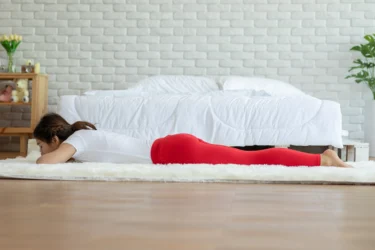Benefits of Makarasana (Crocodile Pose) and How to Do it By Dr. Ankit Sankhe
By Dr. Ankit Sankhe +2 more

Get,

to manage your symptom
Get your,


4 Cr+ families
benefitted

OTP sent to 9988776655



You’ve successfully subscribed to receive
doctor-approved tips on
Whatsapp

Get ready to feel your best.

Hi There,
Download the PharmEasy App now!!


Register to Avail the Offer
Send OTPBy continuing, you agree with our Privacy Policy and Terms and Conditions

Hi There,
Sign up on PharmEasy now!!
Trusted by 4 crore+ families

OTP sent to 9988776655



You have unlocked 25% off on medicines




Code: NU25
By Dr. Ankit Sankhe +2 more
Table of Contents
Nowadays, we are all in the “Hurry-Worry-Curry”. It is a term used to describe our fast-paced lives. It’s a simple description of the tension, stress and improper food habits that engulfs us due to the competitive ways of life1.
This lifestyle has forced many of us to seek refuge in yoga. Yoga is an ancient practice. However, it has only recently been regarded by the western world as a complete approach towards a healthier lifestyle. It is now categorized under Complementary and Alternative Medicine (CAM) by the National Institute of Health2. Yoga is a vast subject and operated through various modalities.

Among the sea of practices that yoga offers, makarasana is one. Makarasana is an easy relaxing exercise. This asana aims at releasing the strain caused by performing other yogic poses. Let us find out more about this unique asana.
Have you ever seen pictures or videos of a resting crocodile slightly lifting its neck and face above the surface of water? The posture of this asana closely resembles this sight. Therefore, it is called makarasana. The word makarasana constitutes of two words, makar and asana where makar means crocodile and asana means posture. Hence, it is also known as the crocodile pose. It is a variation of shalabhasana (locust pose). This is a restorative and relaxing pose and seems to be good for stress management and maintenance of good posture too. There are claims that this posture might be good for the leg muscles, back of the arms and legs, buttock and rear muscles of the body3. Further details about how to perform it are given in the following sections.
You may want to perform this asana in the morning as it is best done empty stomach. These are the makarasana steps that you need to follow:
Kindly ensure that you consult with a trained practitioner before following the makarasana procedure.
There is a fair amount of speculation about the origin of the name makarasna. Though it is believed to mean crocodile, the exact origin of the name might have a deeper meaning. Here are a few beliefs that you might find interesting. These are however not yet proved.
Makarasana benefits for the human health might be as described below:

The crocodile pose might relax the muscles in the lower region of the body, stimulate a triangular bone between the hips (sacrum) and may support the spine. This may allow better flow of prana (life-force) and may aid in removing blockages. Overall, it might have a relaxing effect on all the muscles of the body and improve self-control. This relaxing effect might also lead to a decreased oxygen demand in the body, which may add calmness. However, further studies are required to understand these effects completely3.

Makarasana might be helpful for people with some types of lower back pain. It has been seen that those who suffer from lower back pain, slipped disc and sciatica (pain involving hips and radiating to the leg) might find relief after performing the crocodile posture. Staying in this asana for a prolonged period of time might help normalize the vertebral column’s shape. It might also release the compressed spinal nerves. However, ensure that you practice this after consultation with a doctor and under the guidance of a trained professional3.

The makarasana posture might allow more air to pass into the lungs. Thus, it might be a beneficial practice for those with asthma and other lung diseases. This is one of the simple relaxing asanas which concentrates on breath awareness, making it possibly beneficial for asthmatics3.

The makarasana posture is a unique pose in which the whole body is exercised. Thus, it might facilitate better circulation of blood to the body parts, especially the legs and fingers. This asana might also help in warding off fatigue and general malaise. Moreover, this pose is believed to raise the body’s energy levels by generating subtle energies. Therefore, makarasana may play a vital role in building the body’s strength3.

Makarasana pose might aid in digestion. It was observed that the makarasana posture puts a pressure on the abdomen. It also allows the mind to concentrate on breathing. These effects combine and might strengthen the digestion process. More studies are required to prove these effects1.

Studies4 have shown that makarasana might have a positive effect on the state of mind. It might help relieve stress and fatigue and make the person conscious of their breathing. It might also awaken the kundalini chakra (one of the seven energy centres of the body) which might have a positive effect on the mind. In a study conducted on a group of survivors of a natural disaster dealing with stress, it was observed that a series of exercises including makarasana might help relieve stress. However, more studies are required to confirm these findings1,3.
Along with many other benefits mentioned, Makarasana might also help with maintaining menstrual health in women. Obesity and stress are the primary causes of Polycystic Ovary Syndrome (PCOS). PCOS is mainly characterized by irregular menstruation, acne, anxiety, emotional imbalances, etc. Yoga practices like Shavasana, and Makarasana, along with meditation and pranayama, aid in managing these symptoms and help in maintaining a normal and healthy menstrual cycle6.
Dr. Siddharth Gupta, B.A.M.S, M.D (Ayu)

Research was done on differently-abled people to test the effects of makarasana. It was seen that regular practice showed an improvement of mental ability as well as social and motor skills. Therefore, it was concluded that makarasana might help restore mental and physical health to some degree. However, more research is required to know the complete effects. Therefore, kindly consult a trained yoga instructor for further information5.
Yoga practice may help develop the mind and body; however, it is still not an alternative to modern medicine. You must not rely on yoga alone to treat any condition. Please consult a qualified doctor who will be able to assess your condition correctly and advise accordingly. Moreover, it is necessary to practice and learn yoga under the supervision of a trained yoga teacher to avoid any injuries.
If you are intended to practice Makarasana, you must follow the pattern to gain maximum benefits. Prepare yourself for Makarasana by doing Padma Sadhana, then Bhujangasana, then Shalabasana and then Viparita Shalabasana. Then do Makarasana. Lastly, cool down in Balasana and Savasana7.
Dr. Rajeev Singh, BAMS
The following people might be at risk of performing the crocodile pose:
With the guidance of a qualified and experienced yoga teacher/yoga expert, we can access and analyse the risk factors and continue to practice exercise with precautions.
Also Read: Benefits of Butterfly Pose (Baddha Konasana) and How to Do it By Dr. Himani Bisht
Makarasana yoga is also known as the crocodile pose and may be beneficial for stress-relieving, lower-back pain, sciatica, asthma, calming the mind, etc. The makarasana posture resembles a crocodile resting in water with its head and neck peaking above the water level. It is a relaxing posture done after other asanas. You can perform this asana by laying on your stomach on the ground, slightly lifting your head and shoulders, then crossing your arms at the front with the left arm on the ground and the right above it. The wrists cross at the centre and the fingers meet the inside of your elbows. You can rest your head at the centre, on the wrists, and relax by closing your eyes. After some time, you can open your eyes and release the position. It might be helpful for However, you should seek the guidance of a trained professional before performing it, especially if you are pregnant, have spine or stomach problems.
Also Read: Benefits of Uttanasana (Standing Forward Bend Pose) and How to Do it By Dr. Himani Bisht
Makarasana might be good for the health as it may help in calming the mind, improve the digestive power, bring awareness of breath, etc1,3,5. However, these effects have to be proven by further research. Therefore, kindly consult a doctor for your health problems.
Yes, crocodile pose may be regarded as an easy pose and can be performed by beginners too. It is a restorative asana which focuses on breath awareness and relieving stress3.
Makarasana might be good for relieving back pain. It might also be helpful for people with slipped discs, lower back pain and sciatica3.
The crocodile pose or makarasana might be helpful for digestion as performing it puts pressure on the abdomen and concentrates on breathing which might have a positive effect on the digestive strength1.
Makarasana might be helpful for asthma as it concentrates on breathing and performing it might increase the amount of air flow into the lungs3.
1. Pawar K V., Ital S V., Patil AD, Patil DB. To study the efficacy of Makarasana as an Agnivardhana Karma. J Ayurveda Integr Med Sci [Internet]. 2017 Oct 28;2(05). Available from: https://jaims.in/index.php/jaims/article/view/305
2. Woodyard C. Exploring the therapeutic effects of yoga and its ability to increase quality of life. Int J Yoga. 2011 Jul;4(2):49-54. doi: 10.4103/0973-6131.85485. PMID: 22022122; PMCID: PMC3193654.Available from: https://pubmed.ncbi.nlm.nih.gov/22022122/
3. The Yoga Institute. Makarasana & its benefits – The crocodile posture [Internet]. Mumbai (IN): The Yoga Institute; c2022 [cited 2025 Dec 22]. Available from: https://theyogainstitute.org/makarasana-the-crocodile-posture
4. Telles S, Naveen K V., Dash M. Yoga Reduces Symptoms of Distress in Tsunami Survivors in the Andaman Islands. Evidence-Based Complement Altern Med [Internet]. 2007;4(4):503–9. Available from: http://www.hindawi.com/journals/ecam/2007/327863/abs/
5. Jaiganesh K, Duraisami V, Parthasarathy S. Combined effect of inclusive games and yogic relaxation on the selected domestic skills among physically challenged boys. Int J Yoga. 2011 Jul;4(2):100-1. doi: 10.4103/0973-6131.85493. PMID: 22022129; PMCID: PMC3193652. Available from: https://pmc.ncbi.nlm.nih.gov/articles/PMC3193652/
6. Dei L, Kumar S, Verma A, Dhiman K. Management of PCOS: A Psychosomatic Disorder by Yoga Practice [Internet]. International Journal of Advanced Scientific and Technical Research. 2025;15(2):102–7 [cited 2025 Dec 22]. Available from: https://www.researchgate.net/profile/Laxmipriya-Dei/publication/319082083_Management_of_PCOS_A_Psychosomatic_Disorder_by_Yoga_Practice/links/598ef4d1aca2721d9b6278e2/Management-of-PCOS-A-Psychosomatic-Disorder-by-Yoga-Practice.pdf
7. The Art of Living. Crocodile Pose: Release Tension from the Whole Body [Internet]. 28 Jun 2025 [cited 22 Dec 2025]. Available from:https://www.artofliving.org/us-en/yoga/poses/crocodile-pose
Disclaimer: The information provided here is for educational/awareness purposes only and is not intended to be a substitute for medical treatment by a healthcare professional and should not be relied upon to diagnose or treat any medical condition. The reader should consult a registered medical practitioner to determine the appropriateness of the information and before consuming any medication. PharmEasy does not provide any guarantee or warranty (express or implied) regarding the accuracy, adequacy, completeness, legality, reliability or usefulness of the information; and disclaims any liability arising thereof.
Links and product recommendations in the information provided here are advertisements of third-party products available on the website. PharmEasy does not make any representation on the accuracy or suitability of such products/services. Advertisements do not influence the editorial decisions or content. The information in this blog is subject to change without notice. The authors and administrators reserve the right to modify, add, or remove content without notification. It is your responsibility to review this disclaimer regularly for any changes.
Comments

Leave your comment...
You may also like
Comments